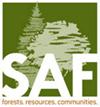造林处理对黄松幼林生长和叶面养分的影响
IF 1.5
4区 农林科学
Q2 FORESTRY
引用次数: 0
摘要
研究了华盛顿东南部6种施肥和除草剂处理(包括对照)下黄松幼林的叶片营养状况、直径和高度生长情况,以诊断叶片营养状况并评价不同造林处理对生长速率的影响。试验采用了两种施肥方法(一种“最佳猜测”的多养分肥料混合施用)和除草剂(撒播或现场施用)。撒播除草剂对树木生长的影响高于现场施用。两种喷施方式可提高直径增量43.3%,而三种点施方式在第三生长期的平均响应仅为14.5%。这两种处理的高生长响应远小于直径响应。与单独施用除草剂相比,施用化肥对树木生长没有显著的促进作用。基于叶面媒介分析的叶面养分对施肥的响应不一致,可能是由于我们实验中使用的一种多养分混合造成的养分不平衡。控制育草产生了处理后快速的早期生长轨迹,表明该人工林的立林是成功的。我们的研究结果也适用于受牧草激烈竞争影响的自然再生黄松幼林。研究意义:考虑到美国西部对重新造林的需求日益增加,我们的研究结果应该为森林管理者提供有用的信息。林分建立是黄松林分发育的关键阶段。在新建立的人工林中撒播除草剂产生了快速的早期生长轨迹。在本试验中,减少激烈的草皮竞争是促进树木生长的最重要因素。我们的研究结果也适用于自然再生的黄松林。作为单独处理或与除草剂联合施用,混合施用多营养肥对树木生长没有显著的促进作用。叶片对施肥的营养反应不一致,可能是由于我们试验中使用的多营养肥料混合造成的营养不平衡。为制定有效的黄松幼林施肥处理,需要进行施肥量和养分组成试验。根据我们的研究结果,当牧草竞争激烈时,不建议施肥而不控制植被。草只在施肥后繁殖,而损害了树木。在我们研究的条件下,我们不能推荐在除草剂的基础上添加肥料,因为施肥并不比单独使用除草剂显著地促进树木生长。我们认为有必要进行施肥率和养分组成试验,以制定有效的黄松幼林施肥处理。黄松林的建立对其未来可能生产的木材及其提供的生态效益至关重要。我们推荐撒播除草剂作为一种有效的造林处理,以控制黄松林分建立过程中的竞争植被(在我们的实验中来自禾草)。我们的研究表明,从植被控制开始的处理后早期生长轨迹表明林分建立是成功的。本文章由计算机程序翻译,如有差异,请以英文原文为准。
Silvicultural Treatments Affect Growth and Foliar Nutrients in a Young Ponderosa Pine Stand
Foliar nutrient status, diameter, and height growth were investigated for young ponderosa pine (Pinus ponderosa) stands grown under six fertilizer and herbicide treatments (including control) in southeast Washington to diagnose foliar nutrient status and evaluate the effects of silvicultural treatments on growth rates. Two application methods of fertilizer (one “best guess” multi-nutrient fertilizer blend) and herbicide applications (broadcast or spot) were used in the study. Broadcast herbicide application produced higher tree growth responses than spot application. The two broadcast application methods improved diameter increments by 43.3%, whereas the average response of the three spot application methods during the third growing season was only 14.5%. Height growth response for these same two treatments was much less than the diameter response. Fertilizer application in addition to herbicide did not significantly increase tree growth over herbicide alone. Foliar nutrient response to fertilization based on foliar vector analysis was inconsistent, possibly due to nutrient imbalances resulting from the one multi-nutrient blend used in our experiment. Control of grass completion produced a rapid posttreatment early growth trajectory and suggested that stand establishment was successful in this plantation. Our results should also be useful in naturally regenerated young ponderosa pine forests subject to heavy grass competition.
Study Implications: Given the increasing need for reforestation in the western United States, results from our study should provide useful information for forest managers. Stand establishment is a critical phase for ponderosa pine stands. Broadcast herbicide application in a recently established plantation produced a rapid early growth trajectory. In this experiment, reducing severe sod grass competition was the most important factor that increased tree growth. Our results may also apply to naturally regenerated ponderosa pine stands. Fertilization with a multi-nutrient fertilizer blend did not significantly increase tree growth as a separate treatment or when combined with herbicide. Foliar nutrient response to fertilization was inconsistent, possibly due to nutrient imbalances resulting from the multi-nutrient fertilizer blend used in our experiment. Fertilization rate and nutrient composition trials are needed to develop effective fertilization treatments in young ponderosa pine stands. Based on our results, fertilizing without vegetation control is not recommended when there is heavy grass competition. The grasses proliferated following only fertilization to the detriment of the trees. For the conditions in our study, we cannot recommend adding fertilizer in addition to the herbicide as a treatment because fertilization did not significantly increase tree growth over herbicide alone. We feel fertilization rate and nutrient composition trials are needed to develop effective fertilization treatments in young ponderosa pine stands. The establishment of ponderosa pine forests is vital for the future timber they may produce and the ecological benefits they provide. We recommend broadcast herbicide as an effective silvicultural treatment to control competing vegetation (from grasses in our experiment) during the stand establishment of ponderosa pine. As demonstrated in our study, the rapid posttreatment early growth trajectory from vegetation control suggests that stand establishment was successful.
求助全文
通过发布文献求助,成功后即可免费获取论文全文。
去求助
来源期刊

Forest Science
农林科学-林学
CiteScore
2.80
自引率
7.10%
发文量
45
审稿时长
3 months
期刊介绍:
Forest Science is a peer-reviewed journal publishing fundamental and applied research that explores all aspects of natural and social sciences as they apply to the function and management of the forested ecosystems of the world. Topics include silviculture, forest management, biometrics, economics, entomology & pathology, fire & fuels management, forest ecology, genetics & tree improvement, geospatial technologies, harvesting & utilization, landscape ecology, operations research, forest policy, physiology, recreation, social sciences, soils & hydrology, and wildlife management.
Forest Science is published bimonthly in February, April, June, August, October, and December.
 求助内容:
求助内容: 应助结果提醒方式:
应助结果提醒方式:


